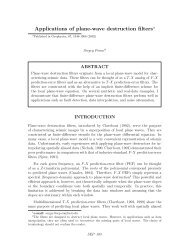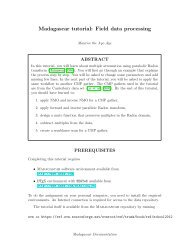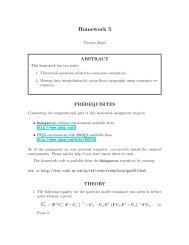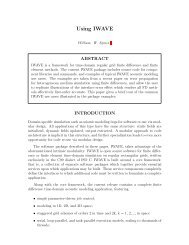Seismic wave extrapolation using lowrank symbol ... - Madagascar
Seismic wave extrapolation using lowrank symbol ... - Madagascar
Seismic wave extrapolation using lowrank symbol ... - Madagascar
You also want an ePaper? Increase the reach of your titles
YUMPU automatically turns print PDFs into web optimized ePapers that Google loves.
Fomel, Ying, & Song 9 Lowrank <strong>wave</strong> <strong>extrapolation</strong><br />
approximation was 2.45 s, the single-processor CPU time for <strong>extrapolation</strong> for 2500<br />
time steps was 101.88 s or 2.2 times slower than the corresponding time for the finitedifference<br />
<strong>extrapolation</strong> (46.11 s).<br />
(a)<br />
(b)<br />
Figure 5: Wavefield snapshot in a simple two-layer velocity model <strong>using</strong> (a) fourthorder<br />
finite-difference method and (b) <strong>lowrank</strong> approximation. The upper-layer velocity<br />
is 1500 m/s, and the bottom-layer velocity is 4500 m/s. The finite-difference<br />
result exhibits clearly visible dispersion artifacts while the result of the <strong>lowrank</strong> approximation<br />
is dispersion-free.<br />
To show that the same effect takes place in case of rough velocity model, we use<br />
first a simple two-layer velocity model, similar to the one used by Fowler et al. (2010).<br />
The difference between a dispersion-infested result of the classic finite-difference<br />
method (second-order in time, fourth-order in space) and a dispersion-free result<br />
of the <strong>lowrank</strong> approximation is clearly visible in Figure 5. The time step was 2 ms,<br />
which corresponded to the approximation rank of 3. In our implementation, the CPU<br />
time for finding the <strong>lowrank</strong> approximation was 2.69 s, the single-processor CPU time<br />
for <strong>extrapolation</strong> for 601 time steps was 19.76 s or 2.48 times slower than the corresponding<br />
time for the finite-difference <strong>extrapolation</strong> (7.97 s). At larger time steps, the<br />
finite-difference method in this model becomes unstable, while the <strong>lowrank</strong> method<br />
remains stable but requires a higher rank.<br />
Next, we move to isotropic <strong>wave</strong> <strong>extrapolation</strong> in a complex 2-D velocity field.<br />
Figure 6 shows a portion of the BP velocity model (Billette and Brandsberg-Dahl<br />
2005), containing a salt body. The <strong>wave</strong>field snapshot (shown in Figure 7) confirms<br />
the ability of our method to handle complex models and sharp velocity variations.<br />
The <strong>lowrank</strong> decomposition in this case corresponds to N = M = 3, with the expected<br />
error of less than 10 −7 . Increasing the time step size ∆t does not break the algorithm<br />
but increases the rank of the approximation and correspondingly the number of the











